
A Zeppelin is a type of rigid airship named after the German inventor Count Ferdinand von Zeppelin who pioneered rigid airship development at the beginning of the 20th century. Zeppelin's notions were first formulated in 1874 and developed in detail in 1893. They were patented in Germany in 1895 and in the United States in 1899. After the outstanding success of the Zeppelin design, the word zeppelin came to be commonly used to refer to all rigid airships. Zeppelins were first flown commercially in 1910 by Deutsche Luftschiffahrts-AG (DELAG), the world's first airline in revenue service. By mid-1914, DELAG had carried over 10,000 fare-paying passengers on over 1,500 flights. During World War I, the German military made extensive use of Zeppelins as bombers and as scouts, resulting in over 500 deaths in bombing raids in Britain.

The airship LZ 37 was a World War I Zeppelin of the German Kaiserliche Marine. It was the first Zeppelin to be brought down during the war by an enemy plane, on the night of 6 to 7 June 1915.
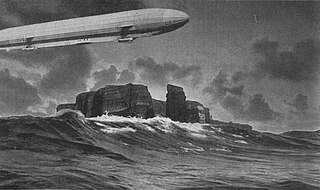
Zeppelin LZ 14, given the navy tactical number L 1, was a rigid airship built for the Kaiserliche Marine to carry out reconnaissance over the North Sea and enemy territory. It was first flown on 7 October 1912. On 9 September 1913, LZ 14 was on a patrol over the North Sea when it encountered a thunderstorm, which resulted in a forced landing/crash. Fourteen crew-members drowned, becoming the world's first ever Zeppelin casualties.
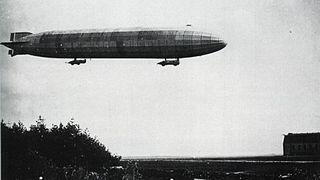
The Zeppelin P Class was the first Zeppelin airship type to be produced in quantity after the outbreak of the First World War. Twenty-two of the type were built as well as twelve of a lengthened version, the Q Class. They were used for many of the airship bombing raids on the United Kingdom in 1915-16, for naval patrol work over the North Sea and Baltic and were also deployed on the eastern and south-eastern fronts.

The Imperial German Army Zeppelin LZ 47 was a P-class World War I zeppelin. Destroyed by enemy fire on 21 February 1916 in the Battle of Verdun, killing the crew of 15.

The Imperial German Navy Zeppelin LZ 48 was a P-class World War I zeppelin.

The Imperial German Navy Zeppelin LZ 53 was a P-class World War I zeppelin.

Zeppelin LZ 38 was Zeppelin P Class airship of the German Imperial Army. It was the first to bomb London, United Kingdom.
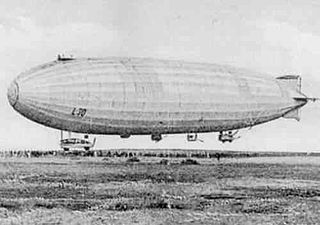
Zeppelin "L 30" was the first R-class "Super Zeppelin" of the German Empire. It was the most successful airship of the First World War with 31 reconnaissance flights and 10 bombing runs carrying a total of 23,305 kg of bombs, with the first ones targeting England, and the four final raids targeting Livonia and Ösel (Saaremaa). At the time of its construction, It was the world's largest Zeppelin, and with its 6 engines, "L 30" could reach speeds higher than 100 km/h, making it the fastest Zeppelin in the world as well.

LZ 72 was an R Class super-zeppelin belonging to the Imperial German Navy. It was commanded by Kapitänleutnant Heinrich Mathy, an experienced commander, and took part in several raids over London during World War I. It also participated in a reconnaissance role during the Sunderland raid of 19 August 1916. Its last flight was launched late at night on 1 October 1916. Several miles north of London, it was caught in searchlights and anti-aircraft fire. During this engagement, 2nd Lt. Wulstan J. Tempest was on patrol and spotted the zeppelin. He proceeded to engage the airship with incendiary rounds, causing the ship to burst into flames and crash in a field near Potter's Bar. After this disastrous crash, the Imperial German Navy began decreasing its amount of zeppelin raids. The entire crew died, and were originally buried there but were transported to Cannock Chase in the 1960s.
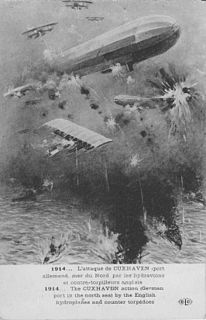
The Imperial German Navy Zeppelin LZ 31 was a M-class World War I zeppelin.

The Imperial German Navy Zeppelin LZ 112, given the tactical number L 70, was an x-class / L70-class World War I zeppelin of the Imperial German Navy.

The Imperial German Navy Zeppelin LZ 64, given the tactical number L 22, was a Q-class / L20-class World War I zeppelin of the Imperial German Navy.
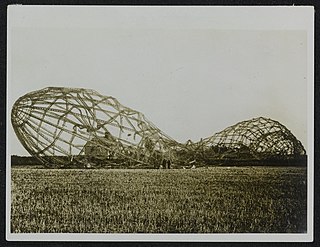
The Imperial German Army Zeppelin LZ 76 (L-m33) was a R-class World War I zeppelin.
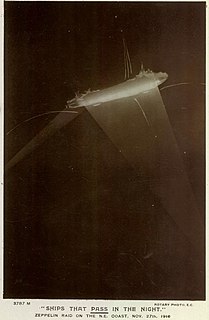
The Imperial German Army Zeppelin LZ 78 (L-34) was a R-class World War I zeppelin.

Zeppelin LZ 89 was an R-class zeppelin of the Imperial German Navy. After a short career during the World War I it ran out of fuel during a mission and was deliberately crashed.

LZ 74 was an R Class super-zeppelin belonging to the Imperial German Navy.
The Imperial German Army Zeppelin LZ 80 (L-35) was a R-class World War I zeppelin.

The Imperial German Navy Zeppelin LZ 86 (L-39) was a R-class World War I zeppelin.

The Imperial German Navy Zeppelin LZ 24 was a M-class World War I zeppelin.



















